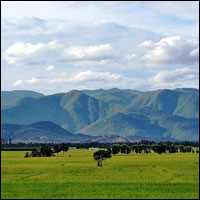The Ministry of Environment and Forests has accepted in principle the report of the high level working group that was constituted in August last year under the chairmanship of Dr. K. Kasturirangan, Member (Science), Planning Commission, to study and make recommendations on how to protect, preserve and nurture the rich biodiversity and environmental integrity of the Western Ghats.
After submission of the report by the working group in April this year, the MoEF sought feedback from all stakeholders including the six Western Ghat states of Gujarat, Maharashtra, Goa, Karnataka, Kerala and Tamil Nadu. After taking into consideration the views expressed, the recommendations made for preventing further degradation of the area’s fragile ecology were accepted.
The working group in its report defined the extent of the Western Ghats and also identified and delineated the Ecologically Sensitive Area. Approximately 37 percent of the Western Ghats is ecologically sensitive. The identified ESA covers 60,000 sq. km. of natural landscape and represents a continuous band of natural vegetation extending over a horizontal distance of 1,500 km. The ESA, spread across the six Western Ghat states, includes protected areas and world heritage sites.
The report by the working group recommends complete ban on mining, quarrying and sand mining and also thermal power plants and red category industries in the ESA. It allows hydro power subject to stringent conditions. Wind energy too has been permitted provided the applicable regulations are followed.
According to the MoEF, mining, quarrying and sand mining, thermal power projects, building and construction projects of 20,000 sq. m. area and above, township and area development projects of 50 ha and above and/or built up area of 1,50,000 sq. m. and above and red category industries would be prohibited in the ESA. However, cases received by Expert Appraisal Committees/State Expert Appraisal Committees/State Environment Impact Assessment Authorities prior to April 17th, 2013, the date on which the report by the working group was put up on the website of MoEF, and pending, would be dealt with as per guidelines applicable at the time of application. Projects and activities not specifically prohibited in the ESA would be scrutinized and assessed for cumulative impacts and developmental needs before granting environmental clearance. As recommended by the working group in its report, the consent of the Gram Sabha for projects in the ESA would be mandatory and the Forest Rights Act observed in letter and spirit.
The report by the working group said that a substantial portion of the Sindhudurg and Ratnagiri districts where moratorium had been imposed falls outside the definition of Western Ghats. It recommended lifting of the moratorium in the two districts subject to certain stipulations.
All the major recommendations made by the working group with regard to financial arrangements for incentivizing green growth in Western Ghats, participation and involvement of local communities in decision making, and data monitoring systems especially establishment of Decision Support and Monitoring Centre, have been accepted by the MoEF.
The MoEF would initiate suitable measures to implement the recommendations made by the working group in its report and issue a draft notification declaring the identified region of Western Ghats as ESA along the lines accepted. A high level committee would be constituted to monitor the implementation of the recommendations in a time bound manner.
The high level working group on Western Ghats was constituted with the objective of bringing synergy between protection of the environment and biodiversity and the imperatives of equity for the indigenous residents of the area.











